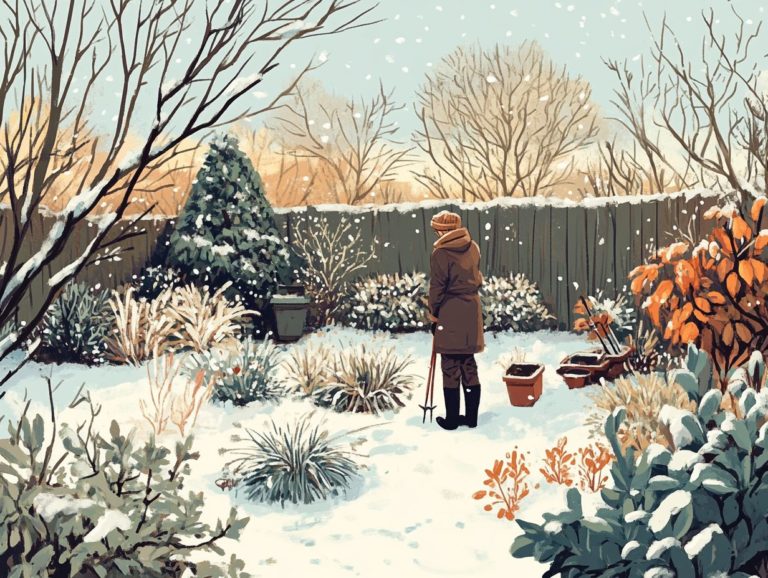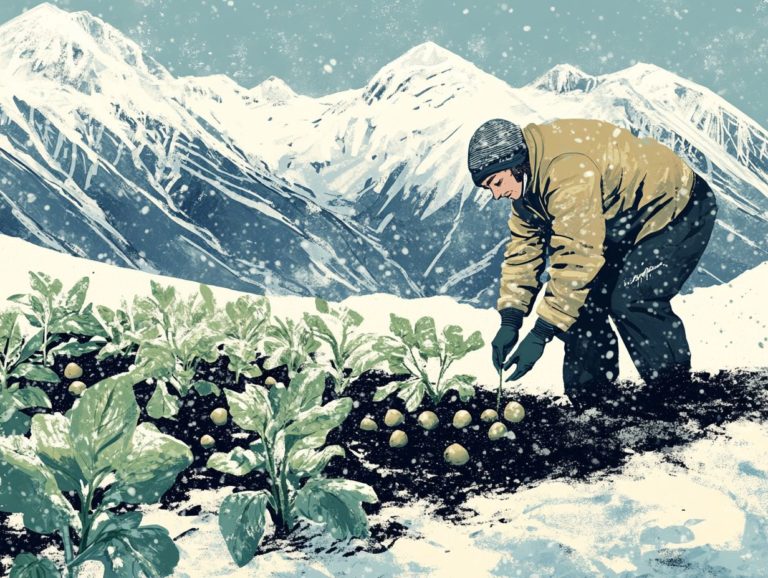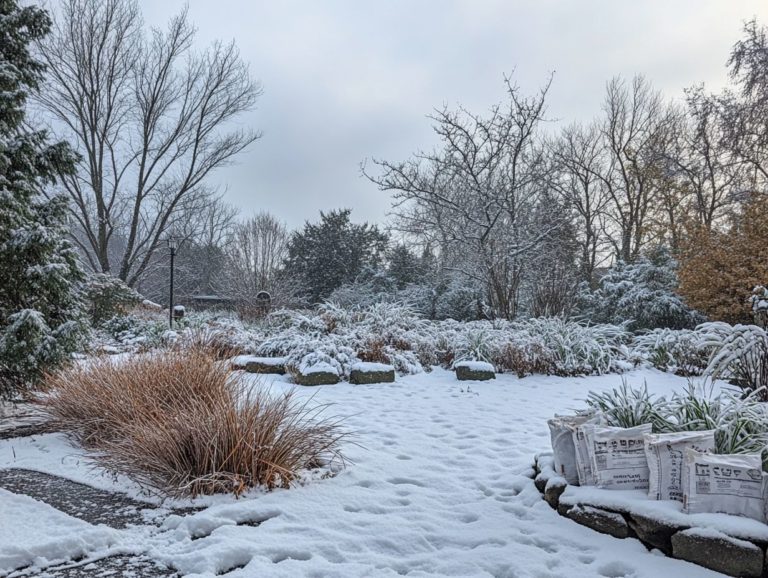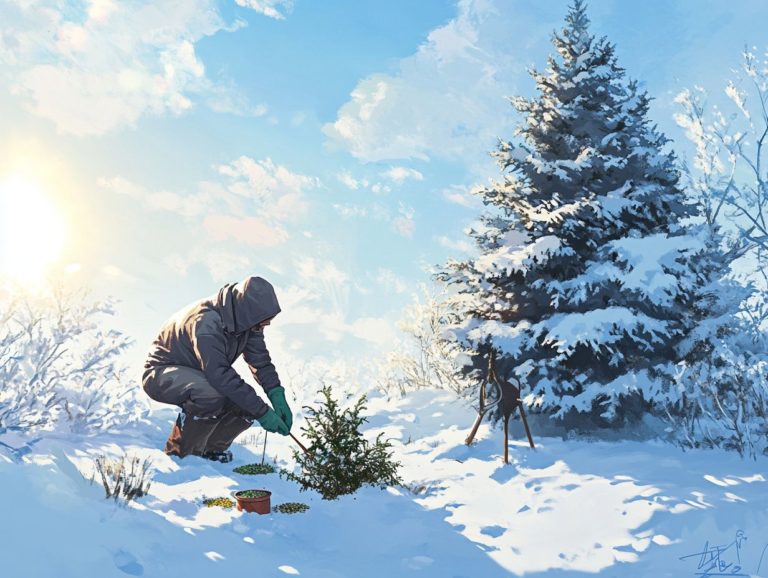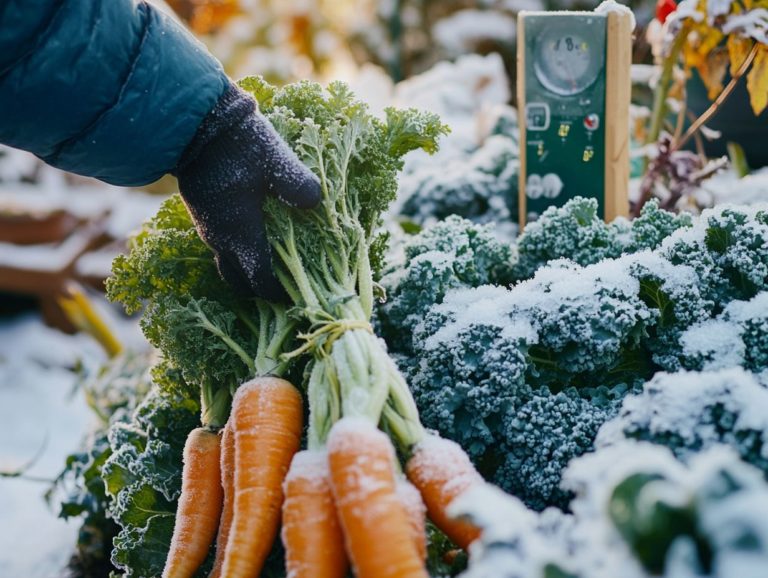How to Choose the Right Plants for Cold Weather?
Choosing the right plants for cold weather, including winter plants, can elevate your garden into a stunning winter wonderland.
To ensure your plants flourish despite the chill, it s essential to grasp key factors such as climate, the USDA’s plant hardiness zones, and soil requirements.
This article delves into various types of cold weather plants, including hardy plants, and distinguishes between annuals, perennials, flowering, and foliage varieties.
You ll also discover the best options suited for different cold weather conditions, along with vital care tips to safeguard your healthy plants.
Embrace the art of winter gardening with unwavering confidence, knowing your choices of native plants will thrive!
Contents
- Key Takeaways:
- Factors to Consider for Cold Weather Plants
- Types of Cold Weather Plants
- Best Plants for Different Cold Weather Conditions
- Caring for Cold Weather Plants
- Frequently Asked Questions
- What are some factors to consider when choosing plants for cold weather?
- What does the plant hardiness zone mean and why is it important when selecting plants for cold weather?
- Are there any specific types of plants that are better suited for cold weather?
- How much sunlight do cold weather plants typically require?
- Do I need to have a specific type of soil for cold weather plants?
- What are some low-maintenance cold weather plants for beginners?
Key Takeaways:

- Choose plants that are suitable for your area’s climate and hardiness zones, which range from 3 to 10, to ensure they can withstand cold temperatures.
- Consider whether the plant is an annual or perennial, and whether it flowers or has foliage, to evaluate its cold weather tolerance.
- Ensure proper care by monitoring water needs and sunlight levels, watering and fertilizing correctly, and protecting plants from extreme conditions.
Factors to Consider for Cold Weather Plants
When selecting winter plants that can thrive in the cold, it’s crucial to understand factors influencing their growth, such as USDA hardiness zones and the specific needs of each hardy plant, including understanding plant selection for cold-climate design.
Choosing hardy varieties suitable for your region can dramatically affect your garden’s success. Local nurseries and conservation organizations offer invaluable insights into the best options for your specific climate, guiding you toward healthy plants that can withstand chilly temperatures and flourish in your flower beds.
By paying close attention to details like soil temperature and water needs, imagine a vibrant garden even during the harshest winter months.
Climate and Hardiness Zones
Understanding climate and the USDA’s plant hardiness zones, from zone 3 to zone 10, is essential for selecting the right winter plants. These zones indicate which plants can survive in specific climates based on their minimum temperature tolerance.
This classification system, crafted by the US Department of Agriculture, categorizes the country into 13 zones based on average annual minimum temperatures, offering you a reliable reference as a plant enthusiast or gardener.
For example, in Zone 3, known for its brutal winters with temperatures plummeting to -40 F, you ll find resilient choices like common juniper and winterberry. Transitioning to Zone 6, where the climate is milder, perennials such as coneflowers, Hostas, and bleeding hearts flourish beautifully. Meanwhile, Zone 10 basks in a subtropical climate, making it a paradise for tropical plants like hibiscus and bougainvillea, showcasing the rich diversity across various climates.
Soil and Sunlight Requirements
Selecting cold weather plants necessitates a keen understanding of their soil temperature and sunlight requirements, as both elements are crucial for fostering healthy growth. For more information, check out this guide on how to select cold-hardy flowers.
Soil temperature plays a significant role in seed germination and root development. Assessing this factor before planting is essential. Water needs and sunlight exposure are equally important; too much water can lead to root rot, while too little may stifle growth. Sunlight exposure differs from one plant to another, with some thriving in full sun while others prefer the gentler embrace of partial shade.
To create the ideal environment for your winter plants, consider using mulches to retain both soil warmth and moisture. Keep an eye on light exposure to ensure your plants receive sufficient sunlight without the stress of excessive exposure. By implementing these strategies and selecting plants for cold climate community gardens, you can cultivate a thriving winter garden that flourishes even in the colder months.
Types of Cold Weather Plants
Cold weather plants come in two main types: annuals and perennials. Understanding these differences can shape your gardening strategy for every season.
Annuals complete their life cycle in one season and bring vibrant blooms like Peony and Hydrangeas. Perennials return year after year, offering dependable color and lush foliage, including Irises and Sedum.
Incorporating flowering shrubs such as Rhododendrons, Lilacs, and Harry Lauder’s Walking Stick introduces stunning springtime flowers. Native plants also require less maintenance and adapt better to your climate.
Select the right combination of these plants, including blueberries and Daylilies, to boost your garden’s beauty and ecological health.
Annuals vs. Perennials
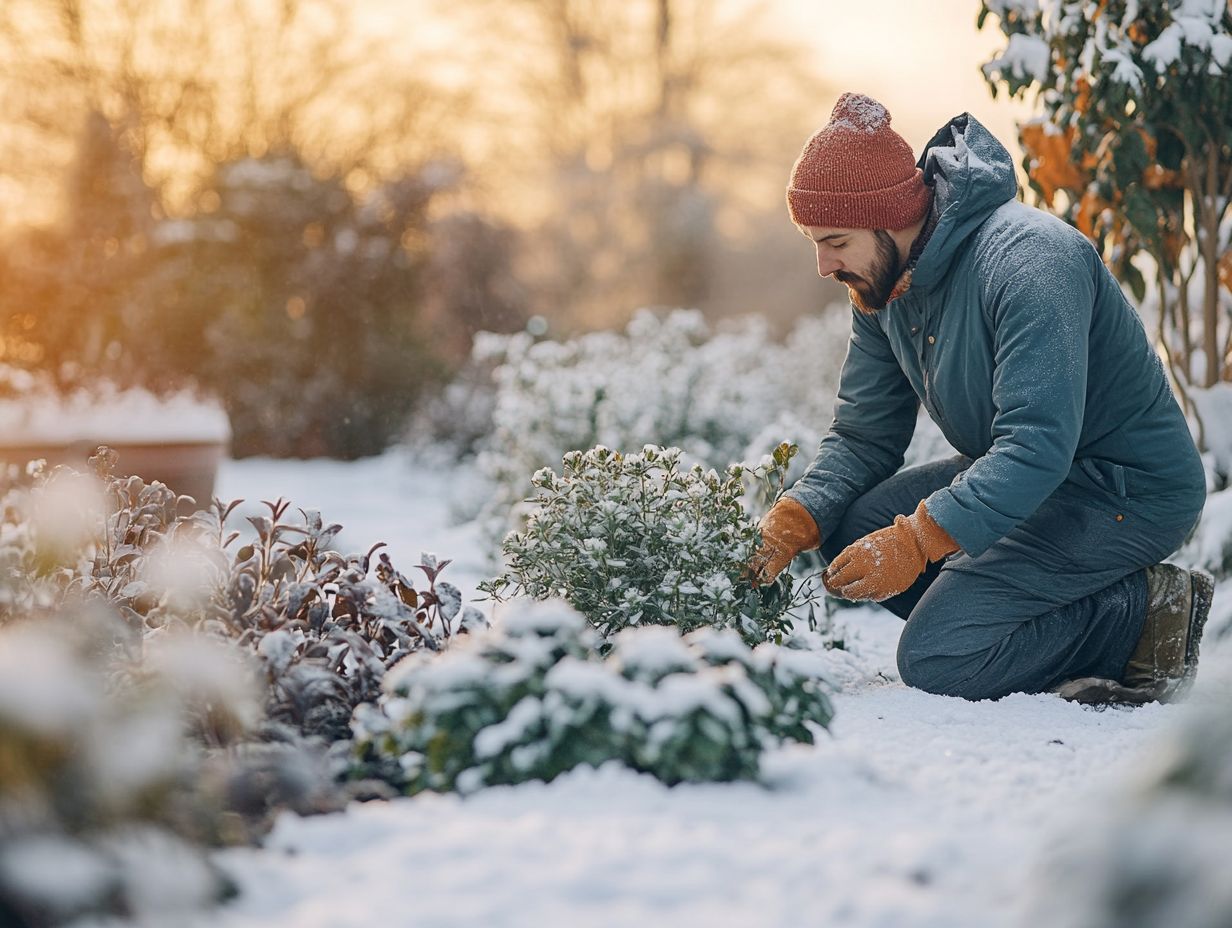
Annuals and perennials have unique traits that affect their performance in colder months. Knowing these differences helps gardeners improve their landscapes.
Annuals provide vibrant blooms that can brighten a winter garden, like Camellia and Hydrangeas. Perennials return each year, offering ongoing visual interest throughout the seasons.
Annuals often need more water and nutrients during the colder months. In contrast, perennials like Hellebores and Sedum show greater resilience and require less upkeep.
Popular cold-tolerant annuals include Pansies, Sweet Alyssum, and Crocuses. To ensure these plants thrive in low temperatures, it’s important to know how to protect your plants in cold weather. Perennials, such as Hellebores and Sedum, provide lasting beauty that withstands chilly temperatures.
Flowering vs. Foliage Plants
Choosing between flowering and foliage plants can elevate your winter garden. Each offers unique visual and functional benefits.
Flowering shrubs like Camellia and Rhododendrons add vibrant color in winter. Their frost-resistant blossoms bring life to your landscape even when other plants rest.
Foliage plants, such as Hostas, Harry Lauder’s Walking Stick, and ornamental grasses, provide depth with their lush leaves. They create a tranquil backdrop that beautifully complements vibrant flowers.
These plants enhance ecological balance by providing refuge for wildlife and improving soil health. Their variety of textures and colors makes your winter garden vibrant and engaging.
Best Plants for Different Cold Weather Conditions
Choosing the right plants for cold weather conditions is essential for keeping your garden vibrant and healthy all winter long. For insights on selecting plants for a winter garden, consider that many plants, especially native varieties, are adapted to handle freezing temperatures and snow.
Consult local conservation organizations like the National Wildlife Federation or the National Audubon Society for advice on native plants that thrive in your area. Integrating these resilient species into your garden creates beauty and strength against winter challenges.
Freezing Temperatures
When facing freezing temperatures, choosing hardy plants, like evergreens and ornamental cabbages, is essential for a successful winter garden. Consider selecting cold-climate plants for urban gardens to ensure your garden thrives even in harsh conditions.
Consider resilient varieties such as bleeding hearts. These tough plants can withstand harsh weather while adding visual interest to your landscape. Optimal placement is crucial; positioning these plants in sheltered areas can shield them from biting winds.
Don t underestimate mulch applying a layer insulates the soil, retains moisture and warmth, and helps regulate temperature fluctuations that can harm delicate roots. This practice ensures your winter plants stay healthy.
By thoughtfully selecting suitable plants, including winterberry, and implementing protective measures, you can create a vibrant and robust outdoor space despite winter s challenges.
Frost and Snow
Understanding how frost and snow affect your garden helps you make informed choices about which hardy plants to include.
Several environmental factors determine the hardiness of flowers and shrubs, especially during the frigid months when many plants, like tulips and daffodils, are vulnerable. By recognizing signs of frost damage or the effects of heavy snowfall, you can take proactive steps to protect your garden.
For instance, perennials like hellebores and certain ornamental grasses, along with blueberries, show impressive resilience against harsh conditions. More delicate varieties may require extra care. By knowing which plants thrive in cooler temperatures and using protective strategies like mulching or using covers you can increase the chances of survival for those at risk.
Caring for Cold Weather Plants
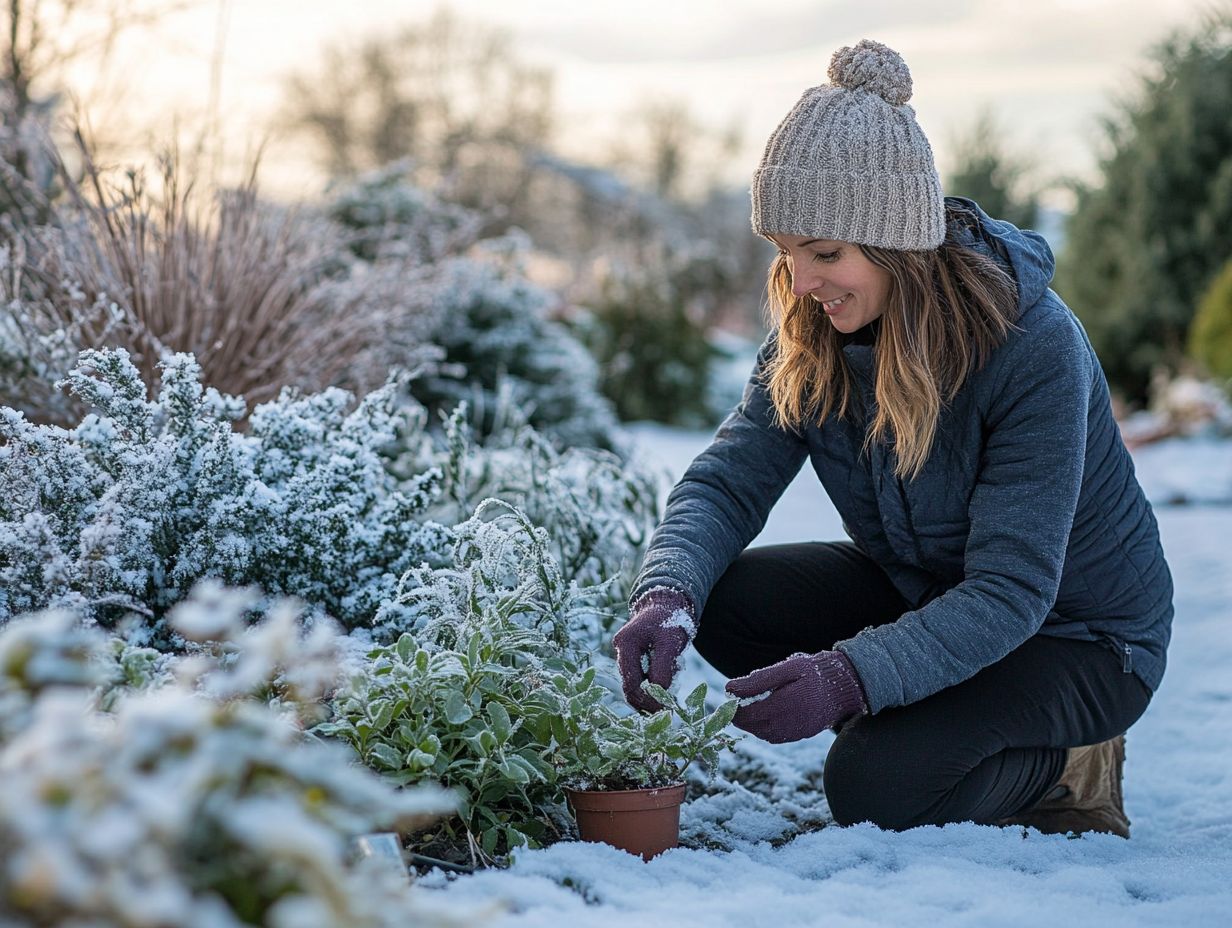
Caring for your cold-weather plants is exciting and essential for their survival, especially during winter’s rigors.
Proper watering and fertilizing are vital for maintaining their health. Throughout winter, understanding their moisture needs and the right time to give nutrients can greatly influence a plant’s resilience against cold.
Using protective measures like frost cloths or windbreaks helps keep your plants healthy and vibrant throughout the season.
Watering and Fertilizing Guidelines
Implementing effective watering and fertilizing guidelines is crucial for maintaining healthy plants during winter’s chill.
During this time, finding a balance is key; overwatering can cause root rot, while underwatering stresses your plants. Start by adjusting the frequency of watering based on your indoor climate and the specific needs of your plants. Typically, watering every two weeks is ideal, but always check the top inch of the soil to ensure it s dry before adding more water.
For fertilizing, use a diluted, water-soluble fertilizer at half strength. This method provides essential nutrients without overwhelming your plants. Avoid fertilizing too often during their dormant phase to prevent potential damage, ensuring your plants stay robust and ready to thrive come spring.
Protecting Plants from Harsh Conditions
Protecting your plants from the harsh winter conditions is essential for maintaining their health and vitality throughout the season.
The chilling effects of extreme cold, frost, and heavy snow can cause stress and damage. Even the hardiest varieties are not immune.
- Layering mulch around the base of your plants serves as an insulating barrier, helping to keep the ground temperature stable and reducing the chances of frost damage.
- Shielding delicate specimens with frost cloth or burlap can provide that much-needed warmth on particularly frigid nights.
- Local conservation organizations offer guidance tailored to your region’s climate challenges. They provide strategies to help you navigate winter’s grip.
Frequently Asked Questions
What are some factors to consider when choosing plants for cold weather?
Some important factors to consider include hardiness zone, sunlight requirements, soil type, and water requirements.
What does the plant hardiness zone mean and why is it important when selecting plants for cold weather?

The plant hardiness zone is a geographical area defined by the average minimum temperature. It helps you understand which plants can survive in your climate.
Are there any specific types of plants that are better suited for cold weather?
Yes, many plants thrive in colder temperatures. For those looking to enhance their gardens, exploring the best native plants for cold climates can provide popular choices like evergreens, conifers, and winter-blooming flowers.
How much sunlight do cold weather plants typically require?
This can vary depending on the specific plant, but most cold weather plants require full sun to partial shade. It is important to research the sunlight requirements of your chosen plants, including sustainable plant choices for cold climates, to ensure they will receive enough light in your garden.
Do I need to have a specific type of soil for cold weather plants?
Cold weather plants can grow in a variety of soil types, but it is important to ensure that the soil is well-drained. When considering your options, selecting plants for shade in cold climates will also benefit from adding organic matter, such as compost, to improve the soil’s quality and provide necessary nutrients for your plants.
What are some low-maintenance cold weather plants for beginners?
If you’re new to gardening, try low-maintenance plants like holly bushes, witch hazel, and winterberry. They’re robust and easy to care for!
Implement these strategies now to ensure your garden not only survives but flourishes this winter season!

